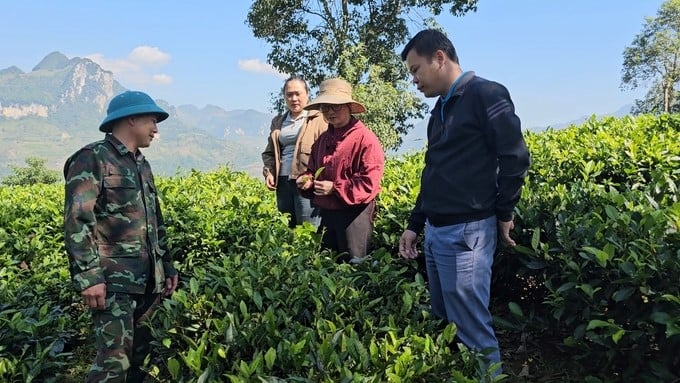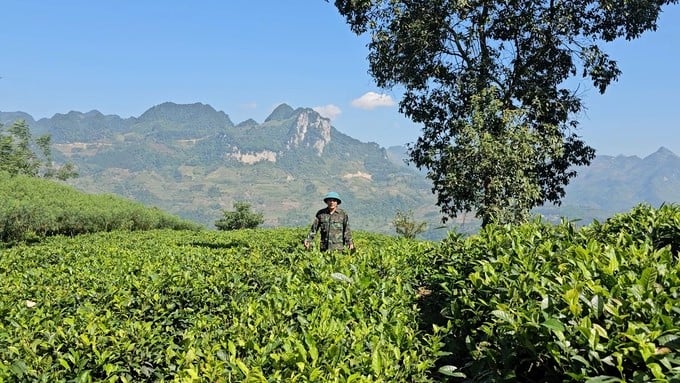May 29, 2025 | 16:00 GMT +7
May 29, 2025 | 16:00 GMT +7
Hotline: 0913.378.918
May 29, 2025 | 16:00 GMT +7
Hotline: 0913.378.918

The local government always pays attention to the tea growing of people in the area. Photo: Hai Dang.
Green tea upland fields have now become a part of the lives of people in Nam Lu (Muong Khuong district, Lao Cai).
Mr. Lung Van Thuong in Nam Ooc village, Nam Lu commune, shared that previously, his family was very difficult. Cultivated corn and cassava have very poor productivity. Only from the day of conversion to growing tea has he accumulated income. Currently, his family earns about VND 70-80 million/year from selling fresh tea buds. Traders and processing factories come to the commune to collect goods at an average price of VND 7,000-8,000/kg. "Compared to corn and rice, growing tea is 10 times more effective," said Mr. Lung Van Thuong.
From the barren upland fields, his family cleared, dug canals, and made beds from 1.5 to 1.7 m, with plants 45–50 cm apart. Caring for the plant is dependent on each area. If it does not rain, it is compulsory to water for the tea plant to be green.
To ensure tea planting and care techniques, the local government has coordinated with specialized agencies to open training classes for people. While studying and applying in their own fields, people can immediately grasp new methods and techniques.
Mr. Lu Van Thon in Nam Ooc village planted more than 1,800 tea roots. "In the first months of the year, I can harvest 3 times a month, and at the end of the year, I can harvest 2 times a month. When the green color of tea leaves is not guaranteed and is no longer dark green, potassium or nitrogen fertilizer must be added. When pests are detected, pesticides must be sprayed according to the instructions of agricultural extension officers," said Mr. Lu Van Thon.
During the tea growing process, in the first 1-2 years, it is mandatory to focus on care and weeding. When the tea tree has a wide canopy and less grass grows, weeding is still required 1-2 times a year. After harvesting, pruning must be done at the end of December to prepare for the spring tea crop.

The green tea upland fields of Muong Khuong people (Lao Cai). Photo: Hai Dang.
Mr. Lu To Hung, Vice Chairman of the People's Committee of Nam Lu commune (Muong Khuong district, Lao Cai), said that implementing Resolution 10 of the Lao Cai Provincial Party Committee on the strategy of developing commodity agriculture, Nam Lu commune of Muong Khuong district identified tea as the stable crop and encouraged the conversion of many ineffective crop areas to tea growing.
However, at first, there were many difficulties because people in the area did not understand tea plants and did not grasp planting and care techniques.
"After being mobilized by the Party Committee and the local government, households in Sao Co Sin village planted the first tea beds. During the implementation process, the commune expanded the tea-growing area in 9/9 villages. Up to now, the whole commune has nearly 400 hectares of tea, of which 220 hectares are being harvested," said Mr. Lu To Hung.
Up to this point, the total tea area in Muong Khuong district is up to 6,000 hectares, exceeding 600 hectares compared to the target that the Resolution of the District Party Congress and Resolution 10 of Lao Cai province assigned to the locality.
Mr. Le Thanh Hoa, Head of the Department of Agriculture and Rural Development of Muong Khuong district (Lao Cai), said that in the district, there are now seven businesses and cooperatives linking to consume fresh tea buds for people, with a total output of about 35,000 tons in 2024.
It is expected that in 2024-2025, the locality will continue to attract two businesses to build two more factories in Muong Khuong town and Lung Khau Nhin commune to consume all products for people. "By 2030, the output of fresh tea buds in the area is estimated to reach 60,000–70,000 tons, doubling current output. Therefore, attracting and building more factories at this time is very reasonable, avoiding the situation of surplus raw materials without a factory to process," Mr. Le Thanh Hoa emphasized.
Translated by Thu Huyen

(VAN) FAO’s Director-General addresses the 5th Baghdad International Water Conference.
/2025/05/26/1716-4-nongnghiep-191706.jpg)
(VAN) Chain linkages, technological innovation, and raw material zoning are three strategic pillars for the coconut industry to strongly develop and elevate its position on the global agricultural map.
![Advanced mariculture – an inevitable trend: [4] Accompanied by scientists](https://t.ex-cdn.com/nongnghiepmoitruong.vn/608w/files/sohk/2025/05/13/1941-pgsts-vo-van-nha-140958_717.jpg)
(VAN) According to Assoc. Prof. Dr. Vo Van Nha, Director of the RIA III, the development of advanced offshore mariculture is no longer an option but an essential path for Vietnam’s fisheries sector.

(VAN) Vietnam is intensifying the development of mollusk farming areas that meet international standards, aiming for sustainable growth and enhancing its export position in the global seafood market.
![Advanced mariculture – an inevitable trend: [3] Policy-driven momentum](https://t.ex-cdn.com/nongnghiepmoitruong.vn/608w/files/doanhtq/2025/05/21/0104-0616-0348-nuoi-bien-170339_789.jpg)
(VAN) To ensure the success of offshore mariculture that uses advanced technologies, it is essential to establish supportive policies that inspire both individuals and enterprises to invest with confidence.
![Advanced mariculture – an inevitable trend: [2] Outstanding results](https://t.ex-cdn.com/nongnghiepmoitruong.vn/608w/files/sohk/2025/05/12/4632-4136-nuoi-bien-11-164117_819.jpg)
(VAN) Pilot models of high-tech offshore mariculture in Vietnam, particularly in the South Central Coast region, have demonstrated exceptional economic returns and sustainability, setting a new direction for the country’s aquaculture industry.
![Advanced mariculture – an inevitable trend: [1] Moving offshore](https://t.ex-cdn.com/nongnghiepmoitruong.vn/608w/files/phucpm/2025/05/18/0252-2436-nuoi-bien-6-162148_783.jpg)
(VAN) Mariculture using advanced technology and moving offshore is an inevitable trend, as nearshore areas increasingly reveal limitations.